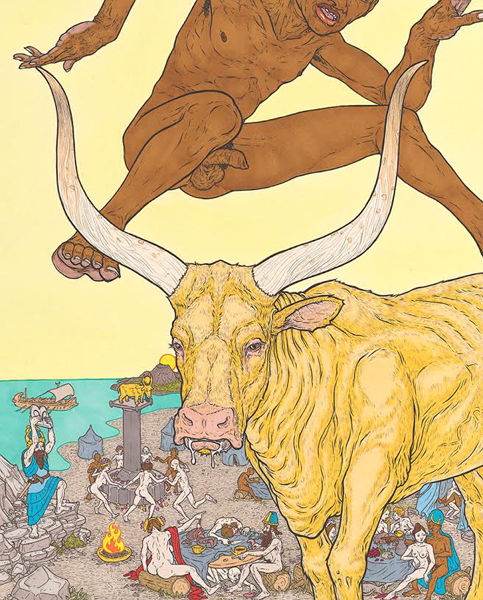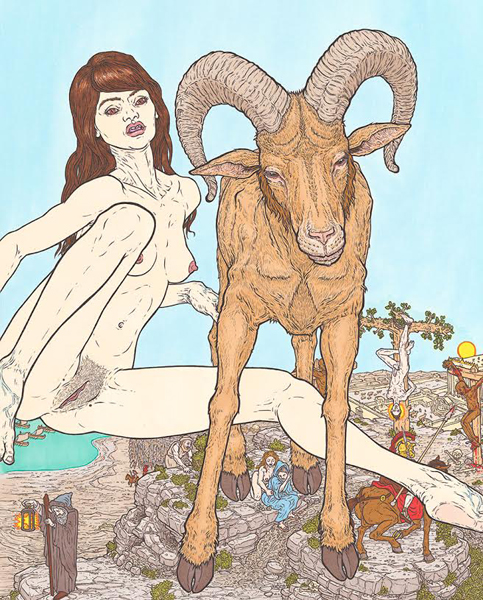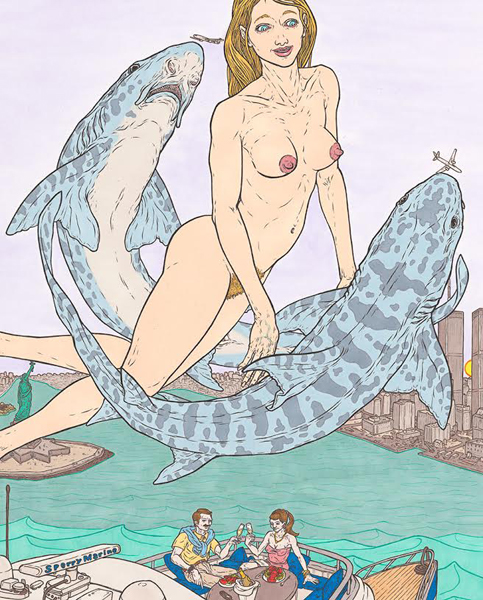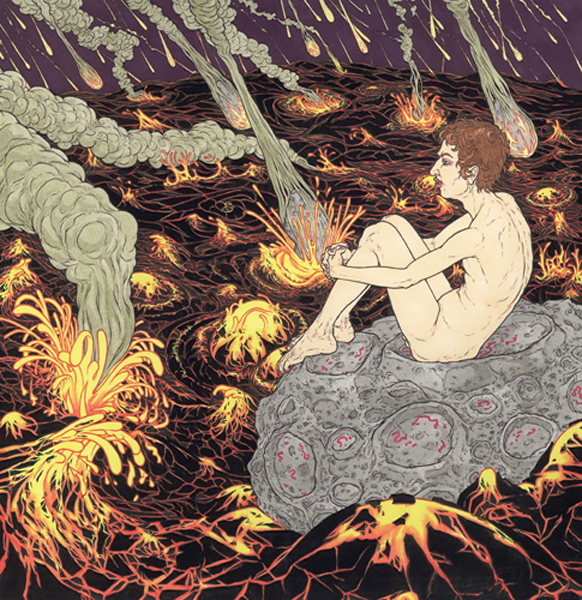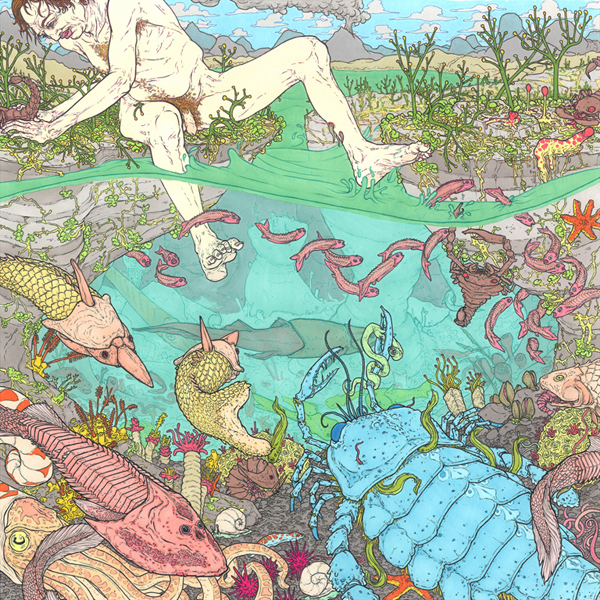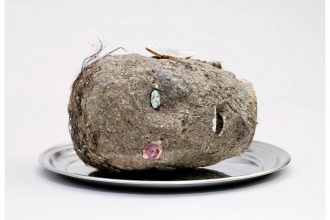Mat Brown is an artist whose primary concern is the immensity of time. His large drawings, rendered delicately with transparent inks on board, resemble science-book illustrations. Yet there is something that activates and separates them from mere illustrations of the ancient world and prehistory. His images are populated by human figures – many of them naked – interspersed between the dinosaurs, ancient mammals, and the primordial soup at the formation of the Earth. The images teem with raw sexuality, yet this titillation is trumped by the barbarity and violence of the natural world depicted. Unlike the fundamentalist Christian position, which states that the Earth is only four-thousand years old, and therefore humans must have lived together with the dinosaurs, Brown’s humans cohabit the world of these ancient beasts as a form of irony, as if to point out our insignificance in comparison to the forces of nature. An accomplished draughtsman, Brown renders his images with elegant lines and delicate washes of ink. This aesthetic is positioned in contrast to the barbarity depicted. The time required to create these series is significant, chronicling the ages of the planet as well as the history of humanity, from the erection of Göbekli Tepe (the first temple ever discovered, predating the invention of agriculture and pottery) to the latest great symbols of civilization, the World Trade Center. I recently spent a few hours with Mat Brown at his studio, located in a house at the end of a lonely street, overlooking the vast natural expanse of Lake Ontario. Here, then, are the ages of Mat Brown.
The Age of Taurus
Brown points at the image entitled Taurus from the Precession of Equinoxes series, about the astrological ages, of which the age of Taurus coincides with the time of the building of the Egyptian pyramids as well as bull worshipping. A Minoan “bull jumper” vaults over the ruminant, chewing its cud without showing any surprise or interest, as a Phoenician ship approaches the harbor, and Moses holds up the Ten Commandment stones.
Is that the golden calf?
Yes. It is the celebration of the end of the age of Taurus. Moses is saying: “get rid of the Golden Calf!” It is also the beginning of the Age of Aries.
The Age of Aries
Aries, from the same series. depicts a seated and splayed female form. Next to her is a ram; the ram’s and the woman’s legs intersect diagonally and vertically to create a “number 4”. A man is being crucified, while images of “the hanged man” in which a man has been hanged upside-down, and “the hermit” (images from the Ryder Tarot deck) bookend the image.
Two thousand years later, it is the end of the age of Aries. And the crucifixion is a signifier for the end of one age and the beginning of the next.
The Age of Pisces
Featuring a central female form surrounded by two sturgeon-like fish, hovering over New York Harbor. a couple relax and imbibe on champagne and lobster aboard a luxury yacht. In the background the World Trade Center can be seen, as a commercial jet plane circles around the towers just before impact.
This represents our recent sacrifice to mark the end of the Age of Pisces and the beginning of the next age.
What I love about it is that when people talk about the 911 attacks. There is always some maligning of the Islamic fundamentalists. But the way in which you portray the scene actually universalizes it. The image deals with historicity, rather than personal or national biases.
Yeah, absolutely. It’s better not to be a nationalist. Of course there has to be a universal and historical context. One has to face the fact that, no! it’s not just the last eighty years that we need to talk about, it’s a perspective of …
Millennia.
Absolutely. And then, we can really have a relationship to that kind of deep time. That kind of time passage. In our daily twenty-first-century lives, we want to ignore that, and just talk about the last eighty years.
We’re not aware of the massive time passage. We know more about the latest additions to Netflix.
Exactly. This is why I make things literal. I think sometimes it’s important to repeat the obvious, you know. Maybe people intuitively know and understand all these things and it’s like, why bother talking about them? But no, to make it concrete is to acknowledge that that’s all there.
The subtext. I was thinking about that in relation to the “prehistoric” drawings. Because there is always a human amongst all the dinosaurs.
Oh yeah.
And it makes me wonder about the idea of whether the images have something to do with structuralism, with our relationship to massive geopolitical forces. Because if you were to put me down there with those sauropods, I would last exactly thirty seconds.
Right.
So, I wanted to ask you, how do you see these images of sauropods and other prehistoric animals, and what do the humans represent in this equation?
The reason I put naked humans in throughout all that stuff is that, that whole story of evolution, and that whole way of dividing time up, and also dividing the animal form up, its physical form, to put the human body in there is sort of to acknowledge that lack of clarity.
We come from them.
Yeah. We are structured out of all these things, from bacteria all the way through, so it’s also an acknowledgment that any of those recreations of “time,” whether it’s about history, or human history from two thousand years ago, or whether it’s from two-hundred million years ago, is all just a continuous projection from the present. So our human body, our twenty-first century perspective is the viewpoint that we’re framing all these things from. So to put a human body in all these prehistoric recreations of a cartoon version of the Age of The Dinosaurs is to say “No! of course it’s just a projection of our present physical bodies or form.”
Yeah, that’s right! And there always seems to be a vanitas; all the human figures are posing. No matter what type of bedlam is going on, the figures are relaxed, self-concerned. And I see that as a vision of our own vanity or –
Maybe they’re just communication, because all these are all symbols and, you know, it’s just an extension of symbolic language; you know, you’re writing an explanation of something, but it’s literally illustrating these concepts. Not just making a pretty picture, but writing a story through these simple line drawings. It’s the simplest form of … well, they’re symbols.
Yeah, it’s funny though, because ever since I met you, you were always, for lack of a better term, a fully realized artist; in the sense that your style was already firmly established. And to me, the drawings are not cartoons at all, in the sense that the paintings of Robert Williams are not cartoons, even though he did make cartoons.
Yeah, absolutely.
But I like this work better than Williams’s because he’s talking about something about our culture, but you’re talking about something universal.
This is the Evolution project, I think it’s almost complete.
That’s really beautiful.
That’s the formation of the earth.
A planetary mass called Theia, according to the “Theia theory,” collided with our planet around 4.31 billion years ago, back when the solar system was forming and there were many more planetary mass-objects in it, thus creating the Moon from the debris of the explosion.
Is that Theia hitting the Earth?
Yeah, that’s what it is, the molten Earth and the combining of the two planets. There’s a little bit of that panspermia [hypothesis that life travels throughout space as resilient bacteria and other microorganisms that “hitch a ride” on meteorites, comets, asteroids, etc.] There’s that period when the Earth and Theia collided, when the moon was being formed, too, and all the debris is raining back down and the mixing of the two planets.
Because all of the orbits of the planets in the solar system at the time had multidirectional paths, and that collision with Theia got The Earth into the “goldilocks” orbit, not too hot, not too cold.
Yeah, exactly. And then the moon was really, really close after that, and that’s where that theory of Theia comes from. Astronomers measured the distance of the Earth to the moon, and discovered that it’s getting further and further away from the Earth. When the astronauts landed on the moon, they put a reflector on the surface so that they could precisely measure the distance. So they shine a light on it – I don’t know if they do it every day, or every year – but they shine a laser and it reflects back from the moon, so they found out that the moon is very slowly moving further and further away. So if you go backwards in time that means that it was closer, and closer, and closer.
And the oceans were out of control due to severe tidal activity.
There were crazy tides and stuff. So back then, the moon would have been huge in the sky, like, taking up half the sky, and really churning the oceans. So it’s the beginning of bacteria, and also crazy volcanic activity all over the Earth, because the crust was being pulled so much.
And this is where the oceans begin to form.
And the thing with the human bodies too, is the whole epistemology of animal form, the history of form itself.
But then it’s sexualized, which is funny because, if we were orangutans or cats, arguably we wouldn’t care much about that, you know, but we care because we’re humans and in a way, it’s talking about where we came from, but also how we look at that. How we look at nakedness and sexuality.
Yeah, and how we see it now.
And it’s like we’re wearing blinders, too. It’s as if someone said, “Hey! Here’s all the knowledge of all time,” but then we became distracted by a hot naked body.
Yes, and I always try to be open about that.
It destabilizes the narrative. I mean, the nudity of the figures in contrast to the scientific forms makes the images really “contemporary,” because now you’re talking about –
The carnality of everything.
The carnality, yeah!
It’s not just supposed to be this, you know, intellectual exercise that, “This is the way the world was.” No. This whole thing was a process of educating myself. It took a long time to learn this stuff.
You had to research it.
I just did it bit by bit, so more than anything, it was an exercise in educating myself. And then to sexualize it, but then also to counterbalance that with some quirky innocence.
But then when you look at everything like a continuum, then the effect it has is almost like looking at a Japanese print of a group of women at a bath house (for instance Women at a Public Bathhouse by Ikkeisai Hoki, aka Yoshiiku, published circa 1865), and then what emerges is that there is really no “shame,” or something analogous to it, as we know it in the Abrahamic tradition.
Yes, exactly. Just the “human-ness.” People who see my stuff once in a while then talk about it like “Yeah, it’s all naked people and violence.” Well, no! I spent five years making drawings of prehistoric animal life.
And they were violent and they had sex and reproduced. And in a way this brings it back to that, because if you look at a trilobite, I mean, two trilobites fucking, you’d go, “What the hell is that?” But humans are having sex in the images.
Well, they do eventually.
Oh they do?
Yeah, I have a big orgy for the finale. I have men and women as well.
Yeah, there’s a man there. A beautiful man.
And there’s the first fish.
Yeah! The first back-boned fish. And there’s Mega Scorpio (Eurypterid). Those guys were badass.
They have a great one at the ROM [Royal Ontario Museum]; they have some great fossils over there. I haven’t been for a while, but when I was doing this project I was going all the time. So this picture shows the time before there was any dirt. There was no soil, but there were the first plants, and they were dying on land. They kept dying and dying, making the first soil. But there’s nothing to eat the plant matter yet. Then it starts up.
Then the amphibians show up.
Yeah, but then you get all these deposits of gas and oil.
Methane.
From the period when there were no animals decomposing, only plants. So there’s millions and millions of years of dying plants.
So there was a lot of carbon dioxide in the air.
Yeah. It was all that plant energy that was never eaten by anything; so now we’re using it up, but there was that period before animals started eating and decomposing the plant matter. What’s missing from all these are the really big pieces like the ones that I’m showing you, the larger ones. Those are all the extinction periods; so there’s an extinction at the end of this period.
That’s the carboniferous forest.
Yeah, you got it, totally. So that was the Devonian.
This is great, I love your palette.
It’s consistent.
You took techniques from cartooning and you applied them to the painting tradition – that’s what I get from the work. It’s like a painting made with a different medium, but adhering to everything that makes painting great.
Yeah, but I mean, It is also one sequential project.
It’s like a project that Hokusai or Albrecht Dürer would have wanted to do.
Or Ernst Haeckel, because he did all his own illustrations, too. He was a scientist, but he was making a catalogue of forms, putting all the animals in categories.
Like Carl Linnaeus did in his Systema Naturae.
Yeah, his taxonomy.
And I guess because back then they were natural philosophers, you did science and you did alchemy; a lot of those people were alchemists, like Kepler.
And they tried to translate it into some symbols. So I was learning about all this stuff as I was going along.
You got the plant life down, you got the giant ferns, the fungi; you really studied this stuff. I’ve never seen this particular creature before; is she an amphibian creature?
Yeah, totally. Here, I’ll show you this, which is really funny. The reason I started doing this project initially – ’cause [at the time] I was just doing all the art fairs and was making one big drawing and selling it, and making another drawing and selling it – is that my parents were leaving their house so I went back to pick up my old art from when I was a kid, and I found that [points at image] from I don’t know how old I was, maybe seven or eight. This one here, was specifically an homage to this piece. I started this whole project because I said to myself, “you know what? Why don’t I just be true to myself and what I’ve always been interested in, which is just honestly investigating the world;” you know? Not in a pretentious, intellectual way, but with curiosity.
Is that an archaeopteryx? [Pointing at another figure in art from Brown’s childhood]
Yeah.
This is so awesome! How old were you when you made this?
I don’t know how old I would have been then.
Look at your name!
My little signature.
You can tell by the sun that you might have been ten or eleven.
Yeah, totally classic clouds and sun. So then I did this drawing as homage to that one from childhood. There’s the Dimetrodon.
Yeah! There he is, with the sun and the clouds.
And I even put the little hole with him coming out of his lair.
So was this the first image that you came up with?
This was the inspiration for the whole project, and that’s when I got to the period of time that the Dimetrodon was from. Then I was like, “OK! I better do it,” just systematically, even though there were no Pterodactyls at the time.
Yeah! You had to keep it chronological.
I had to keep it accurate and move the Pterodactyl to the right time period. I even did the same colors as the kid one; look at the yellow belly.
But the Dimetrodon has a personality; he’s a “happy to know you” kind of Dimetrodon.
Yeah, totally. But that was the inspiration for starting the whole project. Here’s the beginning of the dinosaurs; here’s a Pterosaurus.
That is so weird, too, because then you have these female forms in the new drawings, and they’re so, you know, vulnerable. Like if you took a nude from a Rembrandt painting and you put the person inside a lion cage: carnage. That’s what I get from it. We think we’re all that but we really aren’t.
Yeah, the hubris. Especially now, I think this is making sense to me over the years; I’ve been working on it for so long, but now that idea of humility in the face of it looms large. Now there’s global warming, which is the sort of metaphor for our time. But the way people talk about it is not the power of nature, or the humility of us next to it, but “How can we fix nature.” What we’re doing is we’re still thinking we’re in control of nature; there’s no humility next to it. The way that global warming is talked about, it’s talked about like, “how can we solve this problem, as a powerful, technological people?” And even though they talk about it in a way where it’s like, “People should be responsible with their purchases and their lifestyles”; really what they’re saying is, “Humanity is powerful enough that it can change the course of nature again.” You know? Instead of the other way around. We should be realizing, “No! We better bow down in the face of that stuff.” There’s a sort of nonsense to it.
I guess it’s a paradox, because I think the only way we got here was because we were curious hominids. Our ancestors, Australopithecus Africanus, solved a variety of problems, and that’s why they survived, while specialized “robust hominids” like the Boiseai and all the other hominid species became extinct. Those Australopithecus Africanus individuals probably asked themselves, “The environment’s changing; what can we do to adapt to it?”
Yeah, and I think that people and technology are an extension of nature. We are not separate from nature. Even when we talk about technology, and then nature, we have to use our technology to “solve” nature. No! Technology is nature. You’re part of this planet. We are not separate from the animals. That way of thinking comes from the Enlightenment idea that we’re at the top of the pyramid and we’re separate from the rest of it. And we have to be the guardians.
I see what you mean, because the Enlightenment got rid of God, but it didn’t get rid of superstition; God just got substituted by UFOs, or conspiracy theories, or ghosts or whatever people believe in, like “Hey! nobody went to the moon, it was a hoax. The moon landing was shot in Hollywood.” In the ‘70s, a lot of people believed that Bruce Lee faked his own death and lived in seclusion in the Philippines. Or Erich Von Däniken’s “Ancient Astronauts” theory, which is ethnocentric since he thinks that the Ancient Egyptians, Peruvians, and Easter Islanders were too stupid to build the pyramids, the Nazca lines, or the Easter Island carved heads on their own, without fornicating with and getting technology from space aliens. So this goes with the ideas that you mentioned.
We think that technology is somehow supernatural. Technology is the supernatural in our world now. This kind of “magic,” for most people, is something that they have no understanding of but they do worship; but really it’s just as natural as, you know, amber or anything else.
Yeah! It’s hilarious when you bring it down to that level, because it’s like how the Greeks figured out that the earth was round back in the 6th century BCE, and Erastothenes even figured out the circumference of the Earth around 240 BCE, and he did it by sending a dude on foot from Aswan to Alexandria, by measuring the shadows in both cities and using trigonometry.
It’s very simple, different thinking.
Yeah, this is true for mathematicians, who see everything as numbers.
They’re different languages, right? And this is just putting it into a really simple, childish language. All of this knowledge – I’m not saying I have any real understanding of it – It’s just that this is my own little reflection of all of these concepts, you know.
In the larger pieces the narrative composition is more obvious, from the past, to the present, to the future.
It’s the same with all of the images, because it’s all about time and about the process of the passing of time. The compositions always have a central action in the middle, and there’s a narrative that goes around: past, present and future.
I see what you mean. These are larger works so the compositions are more compacted. It reminds me of the Hieronymous Bosch painting with the circular composition, The Seven Deadly Sins and The Four Last Things (1500).
That’s the traditional sort of composition for Bosch and a lot of Northern Renaissance stuff.
Or Pieter Breugel The Elder.
When it would be a Biblical story or something like that, that’s how they would do it. They would have the three “stages” of the story with the background, and then the foreground, and then the other background. So it’s a narrative style for a single image to have a complete three-act narrative.
Breugel’s The Census at Bethlehem (1566) has a similar preponderance of narrative elements. Robert Williams does the same. But you just have so much information compacted, that it almost becomes a Bosch-style composition, where the elements are so varied that the action seems to fold into itself. It actually transcends a single narrative line. There are multiple stories coalescing and colliding in one picture plane.
Yeah, totally. It mimics the way in which we all have thoughts about these things. It’s always complicated.
























